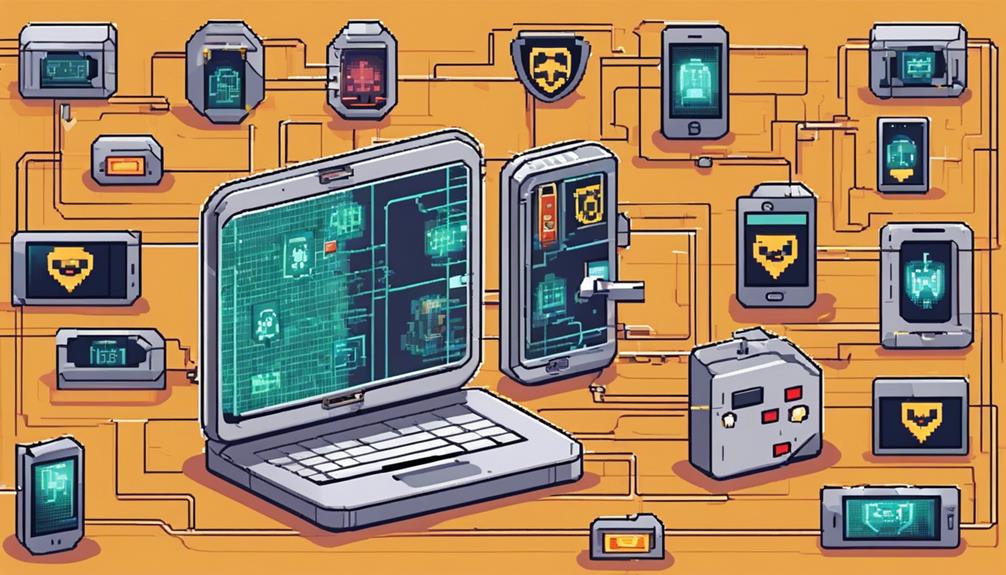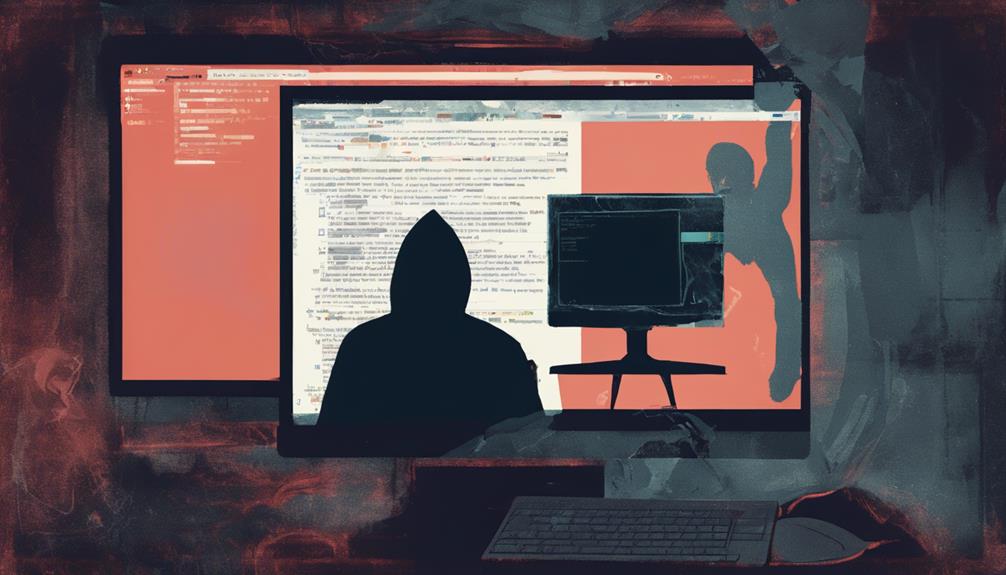Placing your phone in a locked vault when powered off adds an extra layer of security against hackers. When your phone is turned off, advanced hacking techniques are ineffective, keeping your data safer. However, there's still some risk if hackers physically access your device. Signs of hacking include unfamiliar settings or unexpected calls. Preventive measures involve proactive security steps, such as regular updates and avoiding unsecured networks. If you want to safeguard your phone fully, understanding the risks and taking immediate action post-hack are vital steps to protect your device and data. Further information about phone security measures is available.
Key Takeaways
- Enhanced security when phone is turned off in a locked vault.
- Prevention of hackers from listening in due to powered-off state.
- Data safety from remote hacking when phone is completely powered off.
- Extra layer of physical security provided by a locked vault.
- Hackers unable to access data with phone powered off, enhancing security.
Phone Security When Turned Off
When your phone is turned off, it greatly enhances the security measures against potential hacking activities. Turning off your phone can prevent hackers from listening in, as it cuts off access to the microphone and other sensors.
Additionally, advanced hacking techniques like exploiting vulnerabilities in the baseband processor are typically not effective when the phone is powered off.
Keeping your phone in a locked vault when turned off adds an extra layer of physical security against potential hacking attempts. While turned off, your phone's data is generally safe from remote hacking unless physical access is obtained.
It's important to make sure your phone is completely powered off and not in a sleep or hibernation mode to maximize security from potential hacker threats.
Risks of Hacking When Phone Off

There remains a potential risk of data compromise through physical access to a powered-off phone, despite its enhanced security measures. If a hacker gains access to your device, they may still be able to retrieve sensitive information stored on it, including data from online accounts and text messages. While turning off your phone can protect against remote hacking attempts, it may not safeguard your data entirely from skilled individuals with physical access.
Although storing your phone in a locked vault when turned off adds an extra layer of security, it is essential to understand that no method is infallible. To further fortify your phone's security, consider utilizing encryption tools or secure storage methods for any confidential data.
While the likelihood of a phone being hacked when turned off inside a locked vault is low, it's important to remain vigilant and take additional precautions to protect your information from potential breaches.
Signs of Phone Hacking

To identify potential instances of phone hacking, individuals should remain vigilant for various signs that may indicate unauthorized access or compromised security. Learning to recognize the signs of phone hacking is essential for maintaining the security of your device.
Here are some key indicators to watch out for:
- Unfamiliar Apps: Keep an eye out for any new apps or settings that appear on your phone without your knowledge.
- Unexpected Messages or Calls: If you receive strange text messages or calls that you weren't expecting, it could be a sign of hacking.
- Unauthorized Purchases: Check your accounts regularly for any unauthorized purchases that may have been made through your phone.
- Device Performance Issues: Slow performance, frequent crashes, overheating, quick battery drain, increased data usage, and strange behavior are all potential signs of hacking activity.
Preventing Phone Hacks

Implementing proactive security measures is essential for safeguarding your phone against potential hacking attempts. To prevent unauthorized access, regularly review your account settings and enable two-factor authentication to add an extra layer of protection.
Be cautious of suspicious login attempts and immediately change your password if you suspect any unauthorized activity. Hackers often try to gain access through phishing emails or fake websites, so double-check URLs before entering login credentials.
Updating your phone's software is vital as manufacturers frequently release security patches to address vulnerabilities. Avoid connecting to unsecured Wi-Fi networks, as they can be breeding grounds for hackers.
Strong passwords with a mix of letters, numbers, and symbols are harder to crack, reducing the risk of unauthorized entry. Periodically monitor your phone for any unusual apps, data spikes, or device behavior changes, as these could indicate a potential hack.
Immediate Actions Post Hack

Upon detecting a hack on your phone, the immediate actions post-hack are essential to mitigate further data exposure and secure your device.
To effectively respond to a phone hack, consider the following steps:
- Turn off your phone: Immediately power down your device to prevent hackers from accessing more of your data.
- Disconnect from all networks: This includes Wi-Fi and mobile data to limit the hacker's ability to gather information.
- Inform your contacts: Notify your contacts about the potential breach, especially if sensitive information was accessed, to raise awareness and prevent further spread.
- Change your passwords: It is important to change all your passwords, including those for social media accounts, to prevent unauthorized access to your personal information.
Using Anti-Malware Software

In response to potential phone hacks, leveraging anti-malware software such as Clario antivirus becomes essential for detecting and eliminating malicious software, even when your device is powered off and secured in a locked vault.
Regularly running anti-malware scans can prevent hackers from accessing your phone through malware or spyware. These tools are designed to identify and remove hidden threats within your phone's system, enhancing its overall security.
By utilizing anti-malware software, you can protect your personal information and block unauthorized access to your device, even when it's stored in a locked vault. Investing in reputable anti-malware solutions is a proactive measure to safeguard your device from potential hacking attempts, providing an added layer of defense, especially when your phone is turned off and secured.
Remember that prevention is key when it comes to cybersecurity, and anti-malware software plays an important role in keeping your device safe from malicious attacks.
Protecting Your Wi-Fi and Data

Safeguarding your Wi-Fi network and data integrity is paramount in thwarting potential hacking threats, even when your phone is securely stored in a locked vault. To protect your information effectively, consider the following measures:
- Turn off Wi-Fi when not in use: Disabling your Wi-Fi connection when you are not actively using it reduces the chances of unauthorized access to your network.
- Use strong passwords: Secure your Wi-Fi network with a complex password to make it harder for hackers to breach your system.
- Utilize data encryption tools: Implement encryption tools to add an extra layer of security, making it more challenging for hackers to intercept your sensitive data.
- Beware of public Wi-Fi networks: Public Wi-Fi hotspots are prime targets for hackers. Avoid connecting to these networks when handling confidential information, even if your phone is turned off.
Removing Suspicious Apps

Eliminating suspicious apps from your phone is essential for maintaining your device's security. By managing app permissions and uninstalling unknown apps, you can prevent potential security breaches and protect your personal information.
Regularly reviewing and deleting apps that you don't recognize or trust can help safeguard your device from unauthorized access and potential hacking attempts.
App Permissions Management
Regularly reviewing and managing app permissions is crucial for maintaining the security of your phone and protecting your personal data. When it comes to app permissions management, here are some key points to keep in mind:
- Removing suspicious apps can prevent unauthorized access to your phone and protect your data from potential hacking attempts.
- Check app permissions regularly and uninstall any apps that request unnecessary access to your personal information or device functions.
- Some malicious apps can disguise themselves as legitimate ones, so it is vital to review all installed apps on your device.
- By removing suspicious apps, you can reduce the risk of malware, spyware, or adware running in the background and compromising your phone's security.
Uninstalling Unknown Apps
To enhance the security of your phone and protect your personal data, it is vital to promptly identify and uninstall any unfamiliar apps that may pose potential risks. Unknown apps can harbor malicious software like malware or spyware, jeopardizing your device's security.
By removing suspicious apps, you can safeguard your sensitive information from falling into the hands of hackers. Regularly check your phone for any apps you don't recognize or remember installing to guarantee a clean device.
Uninstalling these apps is a proactive measure in fortifying your device against potential hacking threats. Remember, staying vigilant and proactive in managing your apps is essential for maintaining the security of your phone.
Prioritize your privacy and security by promptly addressing any unknown or suspicious applications on your device.
Notifying Contacts About Hacks

Informing your contacts about a potential hack is vital in preventing further damage and safeguarding their privacy. By promptly notifying them through alternative means and advising caution, you can help mitigate the risks associated with hacking incidents.
Implementing an action plan that includes changing passwords, enhancing security measures, and staying vigilant is essential for addressing the aftermath of a hack effectively.
Contact Notification Importance
Notifying contacts about potential hacks plays an essential role in preventing the further dissemination of malware or unauthorized access. When it comes to safeguarding your digital security, keeping your contacts informed is paramount.
Here are some key reasons why contact notification is of utmost significance:
- Preventing Spread: Informing contacts can help them steer clear of interacting with compromised accounts or devices.
- Hindering Exploitation: Quick notification can thwart hackers from exploiting personal connections or sensitive information.
- Enhancing Awareness: Keeping contacts in the loop fosters collective cybersecurity awareness and protection.
- Encouraging Collaboration: Prompt communication can lead to collaborative efforts in addressing and resolving security breaches.
Privacy Concerns Addressed
Addressing privacy concerns when notifying contacts about potential hacks is essential for mitigating security risks and safeguarding sensitive information. By informing your contacts about a possible hack, you not only protect them from falling victim to the same security breach but also prevent the spread of malware or unauthorized access. This proactive approach helps in minimizing the impact of a potential hack and guarantees that your contacts' privacy and data remain secure.
Additionally, alerting your contacts showcases responsible digital behavior and fosters a safer online environment for everyone involved. It is vital to act swiftly when suspecting a hack to prevent further harm and maintain the integrity of your digital network. Keeping your contacts informed about security incidents demonstrates a commitment to cybersecurity and helps in building trust among your peers in the digital world.
Prioritizing privacy concerns when addressing potential hacks is paramount in safeguarding both your data and that of your contacts.
Action Plan Suggestions
To effectively communicate potential security breaches to your contacts, it is imperative to promptly relay any suspicious activity or messages originating from your compromised device. When notifying your contacts about possible hacks, consider the following action plan suggestions:
- Inform them of any suspicious activity or messages they may have received from your compromised device.
- Advise them to be cautious of any unusual requests or messages coming from your accounts that could be a result of hacking.
- Encourage them to update their security measures and passwords if they have recently interacted with you online or through messaging.
- Provide guidance on how to recognize signs of a compromised device, such as strange behavior or unauthorized access to accounts.
Stress the importance of staying vigilant and reporting any further suspicious activity to help prevent further hacking attempts.
Frequently Asked Questions
Does Turning off Your Phone Remove Hackers?
Turning off your phone can help mitigate hacker threats by reducing remote access opportunities. Rebooting frequently can disrupt potential in-memory payloads. While not a foolproof method, regular reboots and a locked vault feature add layers of defense against hackers.
Can a Phone Be Hacked if Turned Off?
When a phone is turned off, it greatly reduces the risk of hacking as hackers cannot access it remotely. This preventive measure is recommended by security experts like the NSA. Placing the phone in a locked vault adds an extra layer of protection.
Can Hackers Listen in on Your Phone?
Ensuring privacy and security for your phone is paramount. When your phone is off and securely stored, the risk of hackers eavesdropping is greatly reduced. Combining physical and digital safeguards is key.
Can Someone Hack My Phone and See Everything?
When considering the security of your phone, it is vital to acknowledge the potential risks of hacking. Despite precautions taken, there is always a possibility of unauthorized access. Implementing robust security measures is essential.
Conclusion
To sum up, while it may seem like your phone is safe in a locked vault when turned off, hackers can still potentially access it. It is important to be vigilant and take steps to protect your device from hacking, such as using anti-malware software, securing your Wi-Fi and data, and removing suspicious apps.
Remember, the consequences of a hacked phone can be catastrophic, so it's better to be safe than sorry.









